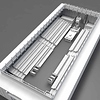I had until recently a Flux 3d printer. It was a surprisingly good printer for the low Kickstarter cost, although the software is in Alpha stage and underwent many changes over my short ownership. There was a substantial learning curve to determine what combinations of settings and material produced good results and the results were frequently and surprisingly inconsistent. It has a cold (non-heated) bed, so PLA is the only option for printing material.
You asked about detail and micron level resolution. Consider that one can see easily layers as small as 50 micron, so even a printer that can go that small will have visible layering. Post processing will allow you to smooth the surface, making invisible those layers. The resolution reference is useful however, for the detail you will print as protrusions or recesses. If you have a ledge or a rail of say 0.5 mm thickness, it would be messy to print with 0.200 mm, as the printer would not be happy with two and one-half layers. Far less messy with 0.100 mm layers, even though print time increases.
Your models also present a number of complications. There are long bridges, horizontally un-supported structures. Expect to have droop from a conventional FFM printer using a single extruder. One can use support material created by the slicer software, but with one extruder, the difficult of removing the supports increases with the complexity of the model, as does the amount of post-processing involved to clear away the little bumps created by the supports.
I’ve recently printed what I would have considered an impossible model, but I used a BCN3D Sigma dual extruder. The second extruder was loaded with PVA wash-away support material. A bit of soaking in the water and most of it fell clear, while the remainder in the high-detail areas eventually dissolved on its own. The detail capacity of the Sigma is great and I’ve not set layers below 0.100 mm with excellent results.
If you are aiming for cheap, you may find your objective to be quite difficult to attain.
Do you have only the one model of which to print ten? 3d printers are not specifically production devices, mainly for prototyping, but ten is a quantity that falls into that arena, in my opinion.
If you purchase a printer, consider that there are virtually no used Sigma printers on the market. You could purchase one, use it to your satisfaction and then sell it used for a small loss and a good return on investment.
